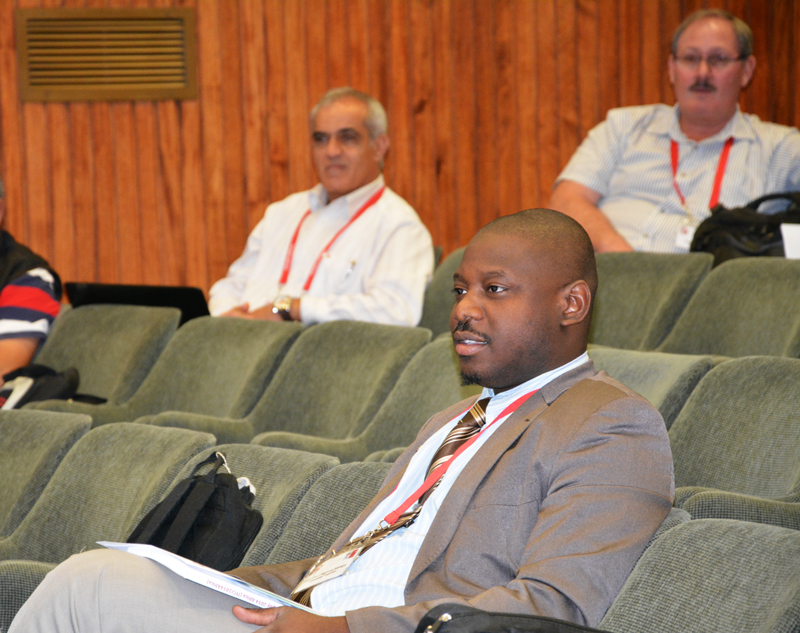Pan African and South African Meeting of the International Year of Crystallography: IYCr2014Africa

By Jean Paul Ngome-Abiaga (UNESCO)
The UNESCO-IUCr Pan African and South African Meeting of the IYCr2014 took place in Bloemfontein, South Africa from 15 to 17 October 2014 with support of the International Union of Crystallography (IUCr), the European Crystallographic Association (ECA), the University of the Free State, the South African Department of Science and Technology and the National Research Foundation. This Pan African and South African Summit Meeting titled “Crystallography as a vehicle to promote science in Africa and beyond” offered an opportunity to African crystallographers, scientists, science administrators, policy-makers and industry leaders to discuss the challenges this science is facing in the African continent. This meeting was an opportune occasion to exchange experiences on difficulties, successes and perspectives on the future of basic and applied sciences in the continent. The summit was also a platform for discussing and sharing new ideas and ways forward to advance crystallography and cutting-edge African scientific research.
Africa is a huge continent, where regions and countries hold different realities and challenges, also regarding crystallography. South Africa, the country hosting the summit, is an example of a country where crystallography is advancing at a fast pace. South Africa has built several partnerships, such as the one with the Wellcome Trust, and since 2003 has been successful in establishing sustainable structural biology infrastructures in the country. South Africa is currently affiliated to the European synchrotron ESRF, which is a major milestone in its long-standing determination to reinforce ties with the international synchrotron radiation community and therefore with local crystallography. In the rest of the continent the situation is more complicated, and an insightful synopsis about the obstacles faced by many African researchers has been formed. The first observations refer to the lack of access to equipment and facilities, therefore decreasing scientific publications and collaboration which is a hindering factor to the regional development of crystallography and science in general.
Secondly, the access to science funding and the mobility of African researchers, within and outside the continent, are issues which were pinpointed during the Summit and which call for a political action from African governments. In addition, the inadequate science policy plans and feeble decisions toward science and crystallography manifest when looking at the data provided on the dates where the first policy strategies have been established in different African countries.
However, some of the delegates reflected excitement, hope and faith in the future establishment of solid crystallography education, research and cooperation in Africa. For example, a partnership with the Cambridge Crystallographic Data Centre (CCDC) led the D. R. Congo to enter in its first research collaboration in the area of structural chemistry. Such a project serves as an example of how structural chemistry research can be embarked upon in a developing country and result in valuable, publishable, innovative research. Kenya was also able to establish international collaborations that recently culminated in the discovery of new bioactive natural compounds. Morocco – a new member of the IUCr – made significant efforts during the last decade to develop science education and basic sciences including crystallography applications to art and cultural heritage.
Due to historical and geographical reasons, Tunisia like most of the North-African French-speaking countries has a preferential scientific cooperation partnership with France, showing that African collaborative activities in crystallography is not enough explored territory still holding a lot of opportunities. An effort towards this has been done through the North African Crystallographic Conferences organized since 2010. In most of the countries the development of crystallography is perceived as an opportunity for tremendous regional industrial applications. Crystallography should be encouraged in Africa, and the IYCr2014 is helping to advocate for this science in the continent. The IYCr2014 is a unique opportunity to address the lack of investment in basic infrastructure, training, cooperation and the use of crystallography-related applications in African countries.
The IUCr together with UNESCO, especially its International Basic Sciences Programme (IBSP), led by Prof. Maciej Nalecz and his team, are combining forces to provide African crystallographers with better opportunities. This mainly through educational and capacity-building activities, especially the IUCr-UNESCO OpenLabs, that will continue beyond the International Year of Crystallography. On top of this a broad political support from the Member States was awoken that led to the Year’s adoption by the UN General Assembly. An official declaration has been produced by the participants of the Summit. This declaration is calling for, inter alia, the creation of an African IYCr Cooperation Fund, the formation of an African Crystallographic Association (AfCA) and the establishment of a scientific visa scheme to ensure mobility between African nations; this will promote the exchange and collaboration of scientific resources and expertise between countries on the African continent. Summit meetings such as the one discussed here enable a deeper understanding of the challenges faced by African countries, as well as the sharing of valuable experiences and ideas that can pave a sustainable path towards development. A better understanding of common obstacles and challenges allows for targeted action from African policy makers to level the playing field in Crystallography and Science, which can ultimately lead the entire continent towards sustainable prosperity. The overall success of the Summit meeting in Bloemfontein was mainly due to the positive spirit of the participants, the dedication of Dr Michele Zema to the IYCr2014, and to the hard work of the local organizer Prof Andreas Roodt.


